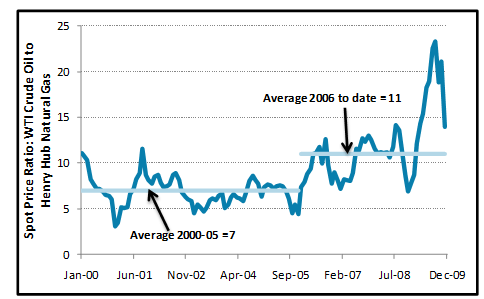Another way of viewing correlations between variables is to graph the relative price of one item against that of another. This analysis is useful for:
- Identifying mispricing opportunities, i.e. assessing the relative cheapness of one item in terms of the other – which is useful in particular for the evaluation of commodity prices.
- Identifying the changing relationships between variables. This could be an indication that the variables are now responding to different drivers.
Let us, for example, consider the following spot price ratio: WTI Crude Oil price to Henry Hub Natural Gas:

The ratio increased from the 2000-05 average of 7:1 to the 2006-09 average of 11:1. This indicates that the relationship between crude oil and natural gas prices began to change in 2006. Crude oil prices increased, which increased residual fuel oil prices but US natural gas prices did not increase. In fact, natural gas prices declined as a result of increased natural gas supply. Lower natural gas prices meant that natural gas generation could now compete with coal-fired generation rather than with its traditional competitor residual fuel oil generation.
In this case, we see that this change in relationship identified is due to the fact that crude oil and US natural gas are responding to different price drivers since 2006. Crude oil prices are impacted by global influences such as Asian demand for and OPEC supply of crude, whereas US natural gas prices are affected by local conditions such as hurricane activity along the Gulf Coast, working inventory levels, industrial gas demand, etc.
